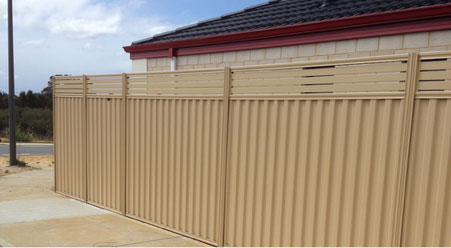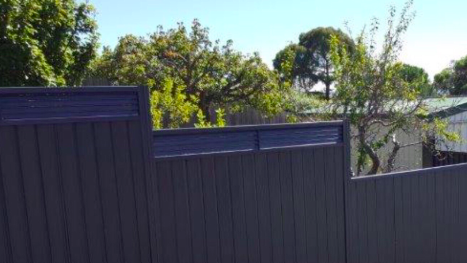Blog Overview
While Colorbond fencing is low-maintenance, regular upkeep is essential to prevent degradation. This involves washing the fence every 3–4 months with mild soap and water, keeping vegetation and garden waste away from the fence line, and immediately addressing any scratches or rust spots with touch-up paint to maintain the finish and warranty.
In this blog you’ll learn:
- How to wash the fence using mild soap and a soft brush.
- Why to keep all nearby vegetation and garden waste trimmed.
- What harsh chemicals and high-pressure washing methods to avoid.
- How to address small rust spots early with touch-up paint.
- Why drainage and small repairs should never be ignored.

Colorbond fencing is one of the most popular and reliable fencing choices across Australia. It’s sleek, strong, and built to handle the country’s varied climates—from the salty breezes of the coast to the heatwaves of inland regions. But while Colorbond fencing is known for its low maintenance, that doesn’t mean it’s maintenance-free.
Over time, exposure to the elements, garden chemicals, and even overgrown plants can wear down your fence’s finish and performance. In this post, we’ll share expert-approved Colorbond fencing tips to keep your fence in top condition. Whether you’ve just wrapped up a new Colorbond fencing installation or your fence has been standing strong for years, these tips will help you extend its life and keep it looking like new.
Why Maintenance Matters for Colorbond Fencing
Colorbond fencing is a premium product, but it still needs care. Regular upkeep:
- Preserves its stylish appearance
- Prevents corrosion or surface damage
- Extends the overall life of your fence
- Protects your property value
- Helps you comply with warranty requirements
Think of maintenance as a small investment that saves you from costly replacements down the track.
1. Wash Your Colorbond Fence Regularly
Why it matters
Over time, dirt, dust, and air pollutants can build up on the surface. If left untreated, they can degrade the painted finish and make your fence look dull.
How to clean it
- Hose it down every 3–4 months
- Use mild soap and warm water for tougher grime
- Wipe with a soft cloth or sponge (not steel wool)
- Rinse thoroughly to avoid residue
Tip: If you’re near the ocean, rinse more often to remove salt buildup that can accelerate corrosion.
2. Keep Vegetation Away from the Fence Line
Why it matters
Plants growing too close to your Colorbond fence can trap moisture and cause mold, mildew, or paint damage.
What to do
- Trim back bushes, shrubs, and trees
- Avoid letting vines climb the panels
- Remove leaf litter, mulch, or garden waste against the fence
This simple habit reduces moisture retention and stops organic matter from damaging the surface over time.
3. Inspect for Damage and Wear
Why it matters
Even the toughest materials can take a hit from a falling branch, rogue footy, or shifting soil.
How to inspect
- Walk along the fence line every few months
- Look for scratches, dents, or loose fasteners
- Check gates and hinges for alignment and ease of use
If you find damage:
- Light scratches can be touched up with Colorbond-compatible paint
- Dents or bent panels may need professional repair or replacement
4. Avoid Harsh Chemicals and Pressure Cleaning
Why it matters
Harsh cleaners and high-pressure washers can damage the protective coating on your fence.
Safe cleaning methods
- Use a soft-bristled brush or sponge
- Stick to pH-neutral soaps
- Never use bleach, ammonia, or acidic cleaners
If using a pressure washer:
- Use low pressure
- Keep the nozzle 30–50cm from the surface
- Use a fan spray rather than a direct jet
5. Address Rust Spots Early
Why it matters
Although Colorbond steel is rust-resistant, scratches or neglected areas can still develop small rust spots, especially in coastal or high-moisture areas.
How to fix it
- Gently clean the area
- Apply a rust converter if needed
- Repaint with matching Colorbond touch-up paint
This quick fix can prevent a small blemish from turning into a bigger problem.
6. Seasonal Colorbond Fencing Tips

Australia’s diverse climate means your fence will face different challenges throughout the year.
Summer
- Rinse off dust and pollen more frequently
- Watch for garden chemicals and pool water splashing against the panels
Autumn
- Clear fallen leaves to prevent mould and moisture traps
- Inspect after strong winds and storms
Winter
- Check for water pooling or boggy ground near posts
- Ensure drainage is working well
Spring
- Perform a full inspection before peak growing season
- Trim back new growth near the fence
7. Common Mistakes to Avoid
Overlooking drainage
Poor drainage around your fence can weaken the foundation and cause warping or post shifting.
Letting plants take over
Climbing vines and heavy shrubs can warp panels and scratch paint.
Delaying small repairs
A small scratch or loose screw might not seem urgent, but it can lead to bigger damage if ignored.
Ignoring warranty guidelines
DIY repairs or improper cleaning methods can void your fence’s warranty.
8. Quick Reference Maintenance Checklist
Monthly:
- Light rinse with hose
- Remove leaves and debris
Quarterly:
- Clean with soap and sponge
- Trim plants around the base
Annually:
- Full inspection of all panels and posts
- Touch up paint on scratches
- Tighten fasteners and hinges
Print this list and keep it handy in your shed or garage for easy reference!
When to Call Professionals for Fence Repairs
Some issues require expert attention to keep your Colourbond fence safe and looking great:
- Significant rust patches or corrosion
- Structural damage from storms or accidents
- Panel replacements or re-painting needs
- Installation of protective barriers or coatings
Jim’s Fencing offers professional inspection and maintenance services across Australia to keep your fence in top condition.
Frequently Asked Questions (FAQ)
How often should I clean my Colorbond fence?
You should perform a light rinse with a hose monthly and a thorough wash using mild soap and a soft cloth or sponge every 3–4 months to prevent the buildup of dirt, dust, and pollutants.
What kind of cleaning products should I avoid using?
Avoid using harsh chemicals such as bleach, ammonia, or acidic cleaners, as well as abrasive tools like steel wool or wire brushes, as these can strip or damage the fence’s protective coating.
Is it safe to use a pressure washer on a Colorbond fence?
Yes, but you must use a low-pressure setting and keep the nozzle a minimum of 30–50 cm away from the surface, using a fan spray rather than a direct jet to prevent damage.
What is the best way to handle vegetation around the fence?
You should trim back all bushes, shrubs, and trees to prevent them from trapping moisture against the panels, which can cause mold, mildew, or paint damage. Do not allow vines to climb the panels.
What should I do if I find a small scratch or rust spot?
Gently clean the damaged area, and then immediately apply matching Colorbond touch-up paint to seal the exposed steel, preventing the small blemish from developing into a major rust or corrosion issue.
Final Thoughts
Colorbond fencing is tough, stylish, and a great long-term investment. But to get the most out of it, a little care goes a long way. With regular cleaning, mindful landscaping, and quick repairs when needed, your fence will remain strong and sharp-looking for decades.
Whether you’re a DIY homeowner or prefer to leave it to the pros, staying on top of your fence’s maintenance is just smart property care.
If you found this article helpful, you may also be interested in:
- Common Colorbond Fence Repairs in Australia?
- Can You Paint Colorbond?
- What Should You Know About Colorbond Fence Installation?
- Colorbond Fence Styles
- How Do You Find the Best Colorbond Fencing Services Near Me?
- COLORBOND® steel Backyard Makeover Winner – Tasmania
- What Are the Best Colorbond Fence Screening Ideas for Aussie Homes?
- How Do You Paint and Clean a Colorbond Fence?
- How Do You Choose and Buy the Right Colorbond Fence?

